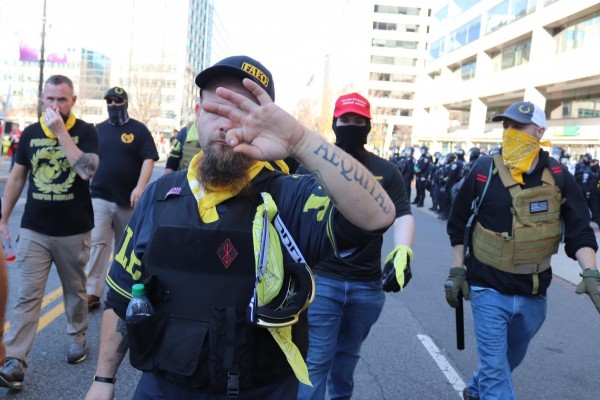Debunking Black Ribbon Day
Lumping together the victims and perpetrators of Nazism and communism is a dangerous form of historical revisionism

“Wonder how long the honeymoon will last?” (1939). Illustration by Clifford Berryman/Washington Star.
August 23 is Black Ribbon Day, recognized by the Government of Canada as an official day of remembrance. It is intended to commemorate the victims of both communism and Nazism in Europe, and as such falls on the anniversary of the signing of the Molotov-Ribbentrop Pact, a 1939 non-aggression treaty between Nazi Germany and the Soviet Union.
In 2020, Prime Minister Justin Trudeau described the pact as follows in an official statement:
This alliance, which led to the violent political and territorial rearrangement of Eastern and Central Europe, caused immense suffering. Millions of people were murdered, countless others robbed of their basic rights, and many more forced to flee their homes and lands.
This is a striking example of the deliberate rewriting of history to suit contemporary geopolitical interests that lies at the very heart of Black Ribbon Day.
Though the Soviet Union did indeed sign a non-aggression pact with Nazi Germany, it was only because months of negotiations with France and the United Kingdom to form a formal military alliance had failed. Hitler, though evidently expansionist and aggressively preparing for war by the end of the summer of 1939, was nonetheless fanatically opposed to communism. The French and British decided that ‘the enemy of my enemy is my friend,’ rejected the Soviet proposal for a defence pact, and the rest, as they say, is history. The deadliest war in human history began less than two weeks later, and would ultimately kill anywhere from 70 to 85 million people across the globe.
Europe was already being rearranged by Hitler well before the Molotov-Ribbentrop Pact was signed. It was hardly a joint effort at mutually beneficial empire building. Similarly, Hitler had been robbing people of their basic human rights, land, homes, and property for years while Canada and the rest of the world ignored the problem and refused to admit Jewish refugees. It is very well-documented: when it came to accepting Jewish refugees from Hitler’s Germany, Canada’s official position was “none is too many.”
This is the history we’re meant to forget because it doesn’t jibe well with our latter day image of openness, acceptance and progressive immigration policies. Indeed, the very next sentence in Trudeau’s 2020 statement reads, “Many of those who fled found refuge and an opportunity to rebuild their lives in Canada.” This flies in the face of history, because Canada’s fundamentally antisemitic immigration polices continued well after the Second World War, during the same time Canada was welcoming hundreds of known (though perhaps thousands of suspected) war criminals and Nazi collaborators, records of which are still kept secret from the Canadian public. What’s more, some of those refugees had spent part of the Second World War destroying the lives of others, as often willing partners in a genocidal campaign of extermination.
It is worth noting as well that while the Soviet Union did in fact occupy part of Poland in September of 1939 (a period known as the ‘Phoney War,’ because the Allies didn’t do anything in response to the Nazi invasion of Poland until May of 1940), they did not occupy Eastern or Central Europe.
Some of those countries, like Austria and part of what was then known as Czechoslovakia, had already been annexed by Hitler. Italy and its empire were already allied to the Nazis, as was Hungary. Within a year or so of the Nazi invasion of Poland, Romania and Bulgaria had sided with Hitler as well, and Nazi-controlled puppet states existed in Croatia and Slovakia. The Baltic states, which had attempted to maintain their neutrality, agreed to Soviet protection at the beginning of the war and were subsequently occupied by the Nazis when they launched Operation Barbarossa and attacked the USSR in 1941.
Holocaust scholars have noted that the civilian populations of the Baltic states were enthusiastic collaborators with the Nazis, particularly so during the Holocaust. In Lithuania, as an example, 95 percent of the country’s Jewish population was massacred in just three years, the most thorough extermination of any Jewish population in the entirety of the Holocaust. It should be noted as well that this was not exclusively the work of occupying Nazi forces but also civilian collaborators and the membership of local fascist organizations who committed thousands of often individual cases of murder, neighbour killing neighbour.
From the Baltic to the Balkans to the Black Sea, Hitler’s occupation of Eastern Europe was aided and abetted by fascist groups that looked to Hitler as a liberator, and who viewed Jews as the agents of international communism.
Joseph Stalin supervising the signing of the Molotov-Ribbentrop Pact by the German Foreign Minister Joachim von Ribbentrop, and Vyacheslav Molotov, his counterpart in the Soviet Union, on August 23, 1939.
This is one of the many reasons why Black Ribbon Day ought not be recognized—not in Canada or anywhere else. The victims of Nazism cannot, and must not, be lumped together with the so-called victims of communism: the ‘victims’ of Soviet forces in the Second World War were the Nazis, their collaborators and the various fascist puppet states who allied with Hitler. Eastern European Jews fled the Nazis to the safety and security of the Soviet Union where they then took up arms to fight back against the Nazis. The USSR was ultimately our ally in the conflict, and picked up the lion’s share of the casualties. Make no mistake, it was the Red Army that did an overwhelming amount of heavy lifting in the conflict, resisting Hitler’s onslaught for years while waiting for the Anglo-American side of the Allied alliance to open up a second front in Western Europe. Moreover, it was Soviet forces who liberated many of the Nazi death camps.
When the prime minister or other politicians ask us to remember the ‘victims of communism’ on August 23, they are inadvertently asking us to remember Nazi collaborators and their supporters.
Black Ribbon Day is inextricably tied to something called the ‘double genocide theory,’ described by Dovid Katz as “the primary new mainstream form of Holocaust Denial.” It’s an idea that gained prominence in the Baltic states towards the end of the 1980s (and in turn was inextricably linked to the efforts of Baltic state nationalists and their supporters in diaspora communities to secede from the Soviet Union). The theory is that Europe suffered from two genocides: one first led by the Nazis against the Jews of Europe, and a second led by the Soviet Union against the local populations of the parts of Eastern Europe that fell under their aegis after the Second World War.
This too is highly problematic: for one, the Nazis didn’t just massacre Jews during the Holocaust, but Roma, Sinti, members of the LGBTQ community, Jehovah’s Witnesses, Slavs, socialists, communists, people with mental and physical disabilities, and all manner of political dissidents. The Soviet Union simply did not carry out genocidal campaigns of extermination against local populations after the Second World War (though the Soviets were far less interested than the Anglo-American allies, Canada most certainly included, in rehabilitating ex-Nazis). This is not to say that the Soviet Union under Stalin was any kind of utopia or that Stalin didn’t commit war crimes and crimes against humanity—the massacre of Polish officers in the Katyn Forest is evidently a war crime, and the Holodomor was certainly a genocidal crime against humanity even if there is still some scholarly debate about whether it qualifies as a genocide.
But to allege that the Soviet Union carried out genocidal campaigns against the local populations of Eastern and Central Europe in the 45 or so years of communist domination after the Second World War is absurd. Aside from the fact that there is no evidence of widespread genocides having occurred during that time, it omits the fact that the majority of the populations of these countries strongly supported both local communist organizations and their Soviet allies, as these were the liberators of much of Eastern and Central Europe.
Supporters of Black Ribbon Day often claim that communism killed 100 million people. This figure is not accepted by any mainstream historian, chiefly due to the fact that it comes from a single source, the The Black Book of Communism, the methodologies of which have been thoroughly discredited. But the book, a “key reference point for the right,” succeeds in trivializing the Holocaust and the crimes of Nazi Germany. Doing so has real world ramifications. Consider as an example how much of the mainstream press has limited coverage, downplayed, or even denied the very real evidence of Nazis and white supremacists in the ranks of the Ukrainian defence forces.
While most Canadians recognize that Holocaust denial is wrong, commemorations such as Black Ribbon Day are designed deliberately to relativize the Holocaust and even the entirety of the Second World War. At a time when hate is growing in our society, we need to ask ourselves whether blurring the historical record, largely to suit contemporary political interests, is making things worse. It isn’t just that antisemitism is on the rise, it is that an alarming percentage of high school students have no idea that the Holocaust even happened.
Canada already has a problem with monuments to Nazi collaborators and war criminals, some of which have received federal funding, and a largely secret history of welcoming war criminals and collaborators while we were still excluding Jewish refugees.
No good can possibly come of this. If those who forget the past are doomed to repeat it, I can’t imagine what fate awaits those who actively participate in the destruction and distortion of the historical record.
Taylor C. Noakes is an independent journalist and public historian from Montréal. In addition to writing regularly for Canadian Dimension, he contributes to the Toronto Star, Jacobin, Cult MTL, The Maple, DeSmog, and the Montréal Review of Books, among others. He holds an MA in Public History from Duquesne University and has worked on the restoration of playwright August Wilson’s childhood home. He is also a frequent contributor to the Canadian Encyclopedia, and once debated several Canadian prime ministers at once on matters of foreign policy.










